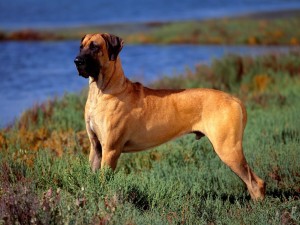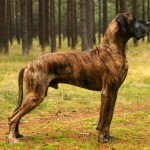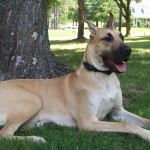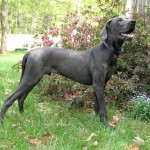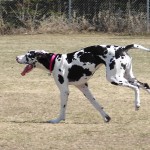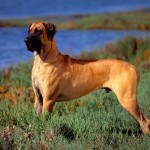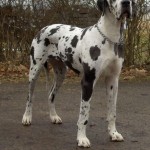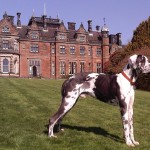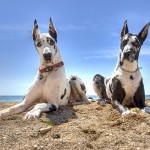Great Dane
"World's record tallest dog was a Great Dane called Zeus. Despite their gigantic size they are very good-natured and friendly."
Other names for this breed:Deutsche Dogge, German Mastiff
Breed nicknames:Gentle Giant
Country of origin:Germany
Traits:
Weight:Male 120–200 lb (54–91 kg), female 100–130 lb (45–59 kg)
Height:Male 30–34 in (76–86 cm), female 28–32 in (71–81 cm)
Coat:Smooth and short
Color:Show-acceptable are Fawn and brindle, Harlequin and Black, or Blue. Otherwise can also be white, merle, merlequin, blue merle, fawn, fawnequin and more.
Life span:8 years, 10 at most
Classification:
AKC - American Kennel Club: Working
UKC - United Kennel Club: Guard
TKC - The Kennel Club: Working
NZKC - New Zealand Kennel Club: Non-Sporting
FCI - International: 2 - Pinschers and Schnauzers, Molossoids and Swiss Mountain Dogs, 2.2 - Molossoid Breeds
Many of us know the Great Dane from popular culture. Famous Great Danes include Scooby Doo, Astro Jetson, and Marmaduke. They may seem like large and possibly scary dogs, but they are surprisingly friendly and sweet. And their history seems to stretch back centuries. Once, they were the dogs of royalty. Today, they are the state dog of Pennsylvania in the United States. Here, we will tell you a bit more background on the Great Dane breed. Perhaps getting to know them a bit better might encourage you to get one of these big dogs yourself!
Description
Whereas other dog breed have a typical range of height and weight, Great Danes have a minimum height at the shoulders and weight for males and females. Males should be at least 30 inches tall and 120 pounds. Females should be 28 inches tall and 100 pounds. Danes have short coats that come in a wide variety of colors, including fawn, blue, brindle, black, harlequin, and mantle. In some areas of the world, this breed often has their long ears cropped. Danes appear to be galloping as they run and are smoothly muscled in body.
History
The Great Dane dates back to ancient Egypt. Boarhounds (the ancestors of Great Danes) also appeared in Ancient Greece, Scandinavia, and Denmark. They were even sometimes referenced in Norse poetry. In Europe these dogs have typically been used as hunting dog for large game, and were very popular among the royalty of Germany and England. Often, they doubled as watchdogs for members of the royal court. For many years this breed was known as the Englische Dogge after going without an actual breed name for years. It was not until the mid-1750s that they were given the name Great Dane.
Temperament
Just because of their size, Great Danes have the tendency to scare people. However, they are incredibly friendly. Rarely does a well socialized Great Dane ever appear to be aggressive when introduced to new people or places. Believe it or not, experts actually recommend that families think about keeping these dogs. They are wonderfully welcoming and good with children with a bit of the right training. Great Danes are also friendly toward other pets like dogs and cats. Be forewarned, however: they will want to get close to you! Great Danes typically love to sit on, with, or be very near their owners.
Dog Care
As you can imagine, the fact that these dogs get so large greatly limits who can take care of them and what sorts of spaces they can be kept in. As you would any other dog, walk them daily. Do not, however, exercise them too much. In older age this can aggravate some of the bone issues that larger dogs have problems with. Do not overfeed them, either. Although they may eat a lot of food and gain weight well after a year of maturity, their metabolism is slower than smaller dogs. Groom them and wash them as needed.
Great Dane Photo Gallery
You can click on the gallery images below to view them full sized (most are in wallpaper resolution!).





















